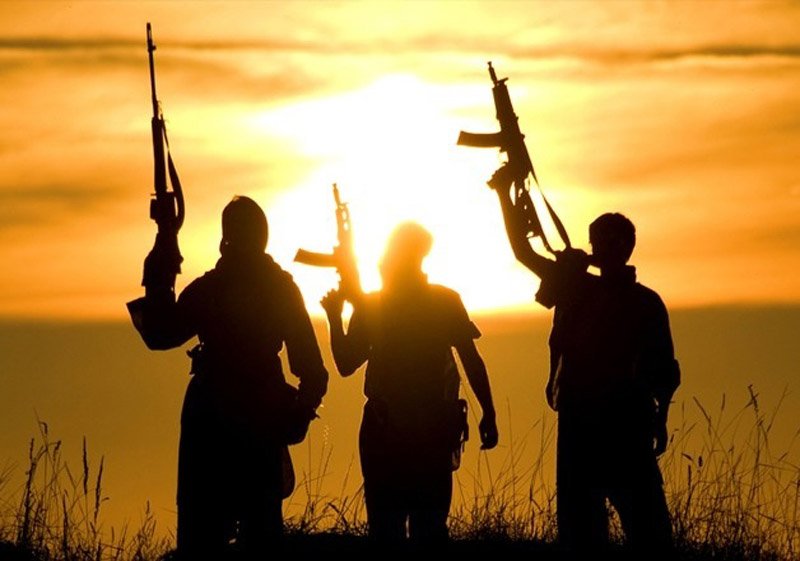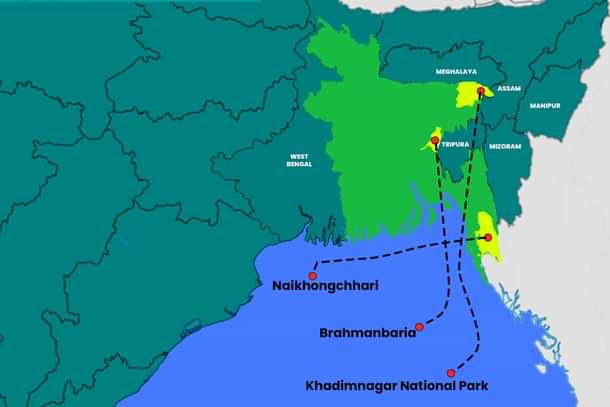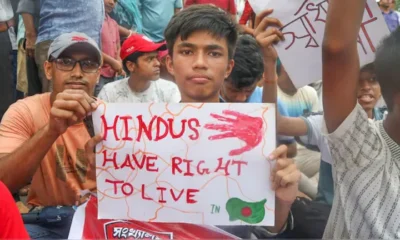Trends
Another Terror Headache for India. Pakistan’s ISI Finds A Foothold In Bangladesh Giving Training To Rohingyas, Islamist Terror Groups
Published
10 months agoon

Bangladesh’s decision to relax visa restrictions for Pakistani citizens, including the elimination of mandatory security clearances, has set off alarm bells in India. The move appears to pave the way for Pakistan’s notorious Inter-Services Intelligence, ISI to strengthen its activities in the region.
Security analysts are raising red flags about a possible strategic and ideological convergence between Bangladesh and Pakistan, with grave implications for India’s national security.
And this thought process seems to be holding true sooner than expected.
Reports suggest that the ISI has initiated training programs for Rohingya refugees and Islamist terror groups in Bangladesh. These activities are reportedly being carried out in several locations –
- Naikhongchhari sub-district of Bandarban district in the Chittagong division,
- Brahmanbaria district, which borders India’s Tripura state, and
- Khadimnagar National Park in Sylhet district, bordering Meghalaya.
Political Shifts and Their Implications
Defence expert Colonel Ajay Raina (Retd.) believes that these developments are part of a larger geopolitical maneuver orchestrated by Pakistan’s ISI with backing from external powers. “It is now well-established that the regime change in Bangladesh was done by the Deep State of the US through Pakistan’s ISI,” he said in an interview.
Colonel Raina further noted the troubling release of previously imprisoned terrorists, some of whom have been integrated into the current ruling structure. He warned, “Very soon, if all goes well with their plans, Bangladesh will practically become East Pakistan like before. The only saving grace might be the eventual collapse of both Pakistan and East Pakistan, ceasing to be a conventional threat to India.”
Training Camps and the Role of Muhammad Yunus
Since his appointment as head of Bangladesh’s interim government in August, Muhammad Yunus has reversed Bangladesh’s long-standing policy of maintaining distance from Pakistan. Under his leadership, ties with Islamabad have strengthened, facilitating ISI operations within Bangladeshi territory.
Intelligence reports reveal that over 50 Rohingyas and around 75 cadres of two Islamic terror outfits—Ansarullah Bangla Team (ABT) and Hizb-ut-Tahrir—are currently undergoing training in camps across the Chittagong, Sylhet, and Brahmanbaria districts.

Naikhongchhari Camp in Bandarban
The Naikhongchhari upazila in Bandarban district, nestled in the Chittagong division of Bangladesh, has emerged as a hotspot for militant training activities.
Once a serene region inhabited by the Marma people, it is now a staging ground for the training of Rohingya refugees in guerrilla warfare, bomb-making, and other subversive tactics. This development, facilitated by the involvement of Pakistan’s Inter-Services Intelligence (ISI), poses a growing threat to regional stability, especially for India.
The Training Camp
At the heart of these activities lies a sprawling camp in the Shali Hills of Gumdum Union, about 23 kilometers east of the Kutupalong refugee camp in Cox’s Bazar. This refugee camp hosts over 950,000 Rohingyas, making it the largest of its kind in the world.
The Naikhongchhari camp, located beside a perennial stream, is under tight security. Police checkposts and patrols by the Border Guards Bangladesh (BGB) restrict access, making the area off-limits to most, including the local population.
Apparently, The training is overseen by at least 10 former Pakistani army officers and soldiers, alongside half a dozen ex-soldiers from the Bangladesh Army.
The Marginalization of the Marma People
Naikhongchhari’s transformation is a tragedy of demographic engineering and displacement. Two decades ago, this region was predominantly inhabited by the Marma people, an ethnic group affiliated with Myanmar’s Rakhine province and predominantly Buddhist.
However, government policies encouraging the settlement of Bengali-speaking Muslims and, more recently, the influx of Rohingyas, have drastically altered the demographic balance. The Marmas, once the majority, now account for just 17% of Bandarban’s population. Entire
Marma villages have been uprooted, including the site of the current training camp. Over the past five years, thousands of Rohingyas have moved into Naikhongchhari and other parts of Chittagong division. This has not only marginalized the Marmas but also created a fertile ground for extremist activities.
The strategic location of Naikhongchhari, close to India’s northeastern border, makes it an ideal site for militant training camps. The involvement of ISI and former Bangladeshi soldiers adds a layer of sophistication to these operations, intensifying the security threat to India and the region.

Training Camp at Brahmanbaria
Likewise, the quiet banks of the Titas River in Masaura, located in the Brahmanbaria district of Bangladesh, have become the site of a covert training camp for cadres of the Ansarullah Bangla Team (ABT). With its remote and inaccessible location, this camp, just 15 kilometers from the Indo-Bangladesh border, is a new flashpoint in the region’s security dynamics.
The camp is strategically positioned in a remote area, reachable only on foot after a grueling three-hour trek. Its isolation ensures secrecy and minimizes the risk of detection. Spread around a football-field-sized clearing, the camp comprises makeshift barracks, trainers’ quarters, a dining area, a kitchen, and a small firing range.
Construction of permanent structures, including an underground armory, is underway, signaling the long-term intent of the operators.
The camp is designed to accommodate around 50-55 individuals, including trainers, supervisors, support staff, and trainees. Large water tanks, a pumphouse, and ongoing infrastructure development illustrate the camp’s capacity and operational scale.
Training Activities and Personnel
The ABT cadres undergoing training are primarily aged 18-25 and are being instructed in guerrilla warfare and arms handling, IED fabrication and deployment, map reading and terrain analysis, and stealth and subterfuge tactics.
The training is led by a former major from Pakistan Army’s Special Services Group (SSG), with support from retired personnel of the Bangladesh Army’s elite Para Commando Brigade. The team includes a retired warrant officer, a former sergeant, and two ex-corporals, all of whom bring specialized expertise in commando operations. Reports suggest that sophisticated weapons and equipment have already been transported to the site.
Proximity to the Indian Border
The camp’s location, just 15 kilometers west of the Indo-Bangladesh border in Tripura, is particularly alarming. The border in this sector is largely unfenced, providing easy access to Indian territory. This proximity raises concerns about potential infiltration and the spillover of militant activities into India’s northeastern states.
The Training Camp in Sylhet
Nestled within the Khadimnagar National Park near Sylhet city, a new training camp for Hizb-ut-Tahrir cadres has emerged as a growing security concern for South Asia.
Operational since mid-November, this camp leverages its strategic location and the involvement of seasoned military trainers to prepare militants for advanced subversive operations. Its proximity to the Indo-Bangladesh border and a key military cantonment shows the camp’s significance and the calculated risks behind its establishment.
Location and Infrastructure
The camp is discreetly located inside the dense forest of Khadimnagar National Park, accessible via a narrow track off the N2 national highway. Its location, close to the Jalalabad cantonment—a hub for the Bangladesh Army’s elite units—provides logistical advantages while maintaining operational secrecy.
The camp features well-camouflaged structures, including barracks, living quarters, underground bunkers, and training facilities. Construction is ongoing, with supervision by a mid-ranking officer from the Directorate General of Forces Intelligence (DGFI), based in the nearby cantonment.
Trainers and Recruits
The camp currently hosts 10 Hizb-ut-Tahrir cadres, with another 30-40 expected to join in the coming months. The recruits are being trained by a former captain of the Para Commando Brigade’s 1st battalion, a senior warrant officer and two sergeants from the same unit, aretired subedar-major and two naib subedars of Pakistan Army’s Special Services Group (SSG).
The DGFI, under its new chief Major General Mohammad Jahangir Alam, is suspected to be facilitating these operations. Alam’s alleged connections to Pakistan’s ISI and the Bangladesh Jamaat-e-Islami raise concerns about deeper geopolitical motivations.
Proximity to the Indian Border
The camp’s location, approximately an hour’s drive from Meghalaya’s Dawki on the Indo-Bangladesh border, is a strategic advantage. This sector of the international border is porous and largely unfenced, making it vulnerable to cross-border movement and infiltration.
The training at the Sylhet camp focuses on sophisticated arms handling and IED fabrication, sabotage of communication networks, intelligence gathering and infiltration into security agencies, and manhunt operations targeting high-value individuals.
These activities indicate a comprehensive training program aimed at equipping recruits with the skills to carry out complex, high-impact operations.
The Role of the DGFI
The involvement of DGFI personnel, particularly under the leadership of Major General Alam, points to possible state complicity or at least a faction within the Bangladeshi establishment supporting these activities. Alam’s controversial appointment and his connections to opposition movements against Sheikh Hasina’s government add another layer of complexity.
The Sylhet camp represents a significant escalation in the security threats emanating from Bangladesh. Its proximity to India’s northeast, combined with the advanced training imparted to recruits, poses immediate risks to regional stability. The porous Indo-Bangladesh border near Meghalaya could facilitate the infiltration of trained militants into India, potentially destabilizing its northeastern states.

Yunus’ Growing Ties with Pakistan
In the aftermath of the Hasina government’s fall, pro-Pakistani factions within Bangladesh’s security establishment have become increasingly active under the leadership of Yunus. These developments signal a shift in Bangladesh’s geopolitical alignment, with significant outreach efforts toward Pakistan.
The Bangladesh Jamaat-e-Islami, a staunch ally of Yunus, has played a pivotal role in fostering closer relations with Pakistan. Since late August, the Jamaat has been dispatching delegations to Pakistan on Yunus’ behalf to lay the groundwork for stronger bilateral ties.
Yunus has demonstrated a keen interest in deepening Bangladesh’s relationship with Pakistan. In a notable move, he held discussions with Pakistan’s Prime Minister, Shehbaz Sharif, on the sidelines of the UN General Assembly in September.
Beyond symbolic gestures, Yunus has advocated for regional cooperation, including calls for the revival of the South Asian Association for Regional Cooperation (SAARC). His efforts also extend to rekindling military cooperation between the two nations.
One of Yunus’ significant policy changes has been the removal of travel restrictions for Pakistani nationals and individuals of Pakistani origin residing abroad. This move has facilitated a steady influx of Pakistanis, including serving and retired members of Pakistan’s armed forces and intelligence agencies, into Bangladesh via Gulf countries since late September.
Cloaked in Secrecy
Reports from Dhaka suggest that immigration processes at Hazrat Shahjalal International Airport are being tightly controlled by officers handpicked by high-ranking police and army officials aligned with Yunus’ pro-Pakistan agenda.
Allegations have surfaced that the arrivals of ISI operatives and former SSG personnel are being deliberately concealed, with entry records reportedly being destroyed to maintain secrecy.
Speculation about a Pakistani military aircraft landing in Dhaka in mid-November has added to concerns over the deepening ties between Dhaka and Islamabad. While these reports remain unverified, they highlight the opacity surrounding these developments.
Pakistan’s Influence in Bangladesh Post-1975
The assassination of Bangabandhu Sheikh Mujibur Rahman in August 1975 marked a turning point in Bangladesh’s relationship with Pakistan. It provided an opportunity for Pakistan to re-establish its influence through key figures in the Bangladeshi armed forces who had secretly maintained ties with Pakistan, as well as through the Jamaat-e-Islami.
The resurgence of Pakistan’s Inter-Services Intelligence (ISI) in Bangladesh began soon after 1975.
By the late 1980s, under Prime Minister Kazi Zafar Ahmed during General Hussain Muhammad Ershad’s military rule, the ISI became actively involved in supporting militant groups from India’s North East. This collaboration intensified during Begum Khaleda Zia’s tenure as Prime Minister starting in March 1991, following Ershad’s ousting.
Hasina’s Pushback
When Sheikh Hasina assumed office in June 1996, she took decisive action to dismantle Pakistan’s influence. The ISI was expelled, and Bangladesh ceased its support for North East Indian militants. Hasina’s government even arrested and extradited several rebel leaders to India, signaling a significant policy shift.
Begum Khaleda Zia’s return to power in October 2001 marked a reversal of Hasina’s policies. Zia, with the support of Lieutenant General Hasan Mashhud Chowdhury—an army chief with ties to Pakistan’s military and a non-participant in Bangladesh’s 1971 Liberation War—rekindled ties with Islamabad.
After Khaleda Zia’s term ended in 2006, General Moeen Uddin Ahmed took control under the guise of a caretaker government. A former student of the Pakistan Air Force College in Sargodha and a former defence attaché to Pakistan, Ahmed had cultivated strong ties with the ISI.
During his tenure as Bangladesh’s de facto ruler from January 2007, Pakistan’s influence grew significantly, though the ISI faced challenges in regaining its earlier foothold in India’s North East.
Instead, the ISI shifted focus to fostering Islamic fundamentalism within Bangladesh, funding and training radical clerics to promote extremist ideologies.
When Sheikh Hasina returned to power in January 2009, she once again expelled the ISI and curtailed Pakistan’s activities in Bangladesh. Her government reinstated policies to curb militancy and dismantle extremist networks, restoring Bangladesh’s sovereignty from foreign influence.
Under Yunus, Pakistan’s influence has resurfaced. Yunus, known for his strained relations with India, has facilitated the ISI’s renewed operations in Bangladesh. This development marks a concerning shift, as Pakistan’s foothold in the country grows stronger under his leadership.

Implications for India
Security experts warn that the training of Ansar al-Islam (ABT) and Hizb ut-Tahrir (HuT) cadres, along with Rohingya refugees, poses a direct threat to India. While ABT and HuT operatives are being prepared to infiltrate Indian borders, the objective behind training Rohingyas appears to be similar.
Unlike groups like the Arakan Rohingya Army (ARA) or the Arakan Rohingya Salvation Army (ARSA), which are engaged in Myanmar’s internal conflicts, the Rohingyas being trained in Bandarban have no ties to these factions or to the Rohingya Solidarity Organisation, a mercenary force supporting Myanmar’s military. This suggests that the purpose of their training is not related to Myanmar’s conflicts.
According to a former expert with the Bangladesh Institute of International and Strategic Studies, the most plausible explanation is that these Rohingyas are being prepared to infiltrate India for subversive activities or attacks on security establishments.
Vulnerabilities Along the Indo-Bangladesh Border
The geographical proximity of the training camps in Bandarban to India’s borders heightens the risk. Mizoram, with its porous border, lies just 60 kilometers east of Bandarban, while Tripura is about 145 kilometers to the north. Both states have unfenced and vulnerable stretches along the Indo-Bangladesh border, making infiltration easier.
Additionally, the border regions of Meghalaya, Assam, and West Bengal are potential entry points for these operatives. This makes it likely that, within six months—the estimated duration of training—India could face a significant security threat in its North Eastern and Eastern states.
Strategic Threat
By mid-next year, India may confront the challenge of well-trained, armed cadres from ABT, HuT, and radicalized Rohingyas crossing the border to carry out operations. This looming threat necessitates heightened vigilance, robust border security measures, and proactive counter-insurgency efforts to safeguard the region from infiltration and potential attacks.
The cyclical nature of Pakistan’s influence in Bangladesh underscores the impact of leadership changes on the country’s foreign policy. With Yunus now at the helm, the resurgence of ISI activities and the strengthening of ties with Pakistan pose significant challenges to regional stability and Bangladesh’s relations with India.
India faces the dual challenge of preventing cross-border infiltration and addressing the broader geopolitical implications of such camps. The use of trained militants for targeted attacks or to foment unrest in India’s northeast could destabilize the region and strain its security apparatus.
You may like
-


Why Is Donald Trump Still Reiterating $21 Million USAID Funding To India, Although It Went To Bangladesh? What Game Is Trump Playing And Why?
-


Meeting That Has India Spooked, George Soros Son And Muhammad Yunus. The Growing Nexus Bangladesh-Pakistan Spells Trouble For India?
-


Trump’s Return. What Lies Ahead For India In A World On Edge? A Lot Of Opportunities If Played Right!
-


Did Bangladesh Just Put A Ban On Resident Hindus From Government Jobs? From Gandhi’s Failed Mission In Noakhali In 1946-47 To The Present, What Being A Hindu Means In Bangladesh?
-


Should India Extradite Sheikh Hasina? Why Hasina’s Extradition Could Hit India’s Image
-


Pakistan Launches Airstrikes In Afghanistan, Killing 15. Taliban Threatens Retaliation. The Perils Of Proxy, Pakistan, The Taliban, And The Evolution Of Terrorism In Afghanistan
